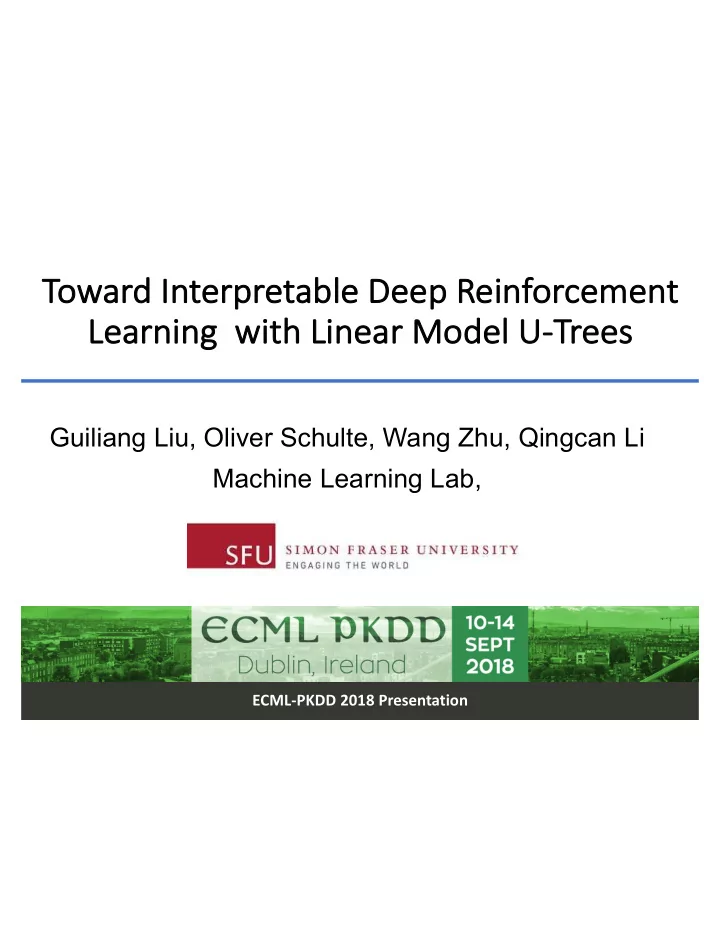

Toward In Interpretable De Deep Re Reinforcement Lea Learning g wi with Li Linea ear Model el U-Tr Trees Guiliang Liu, Oliver Schulte, Wang Zhu, Qingcan Li Machine Learning Lab, ECML-PKDD 2018 Presentation
PROBLEM DEFINITION Understand the knowledge learned by Deep Reinforcement Learning (DRL) Model PROBLEM
MOTIVATION Recent Success of Deep Reinforcement Learning • Game Environment But • Physical Environment MOTIVATION
MIMIC LEARNING Interpretable Mimic Learning Transfer the knowledge from deep model to transparent structure • (e.g. Decision Tree). Train the transparent model with the same input and soft output • from neural networks. knowledge Neural Network Decision Tree MIMIC LEARNING
MIMIC LEARNING FOR DRL Experience Training Setting • Recording observation signals 𝐽 and actions 𝑏 during DRL training. • Input them to a mature DRL model, obtain the soft output 𝑅 𝐽, 𝑏 . • Generates data for batch training. MIMIC LEARNING
MIMIC LEARNING FOR DRL Active Play Setting • Applying a mature DRL model to interact with the environment. / 𝐽 + , 𝑏 + > • Record a labelled transition 𝑈𝑢 =< 𝐽 + , 𝑏 + , 𝑠 + , 𝐽 +-. , 𝑅 • Repeat until we have training data for the active learner to finish sufficient updates over mimic model. MIMIC LEARNING
MODEL Linear Model U Tree (LMUT): • U tree : an online reinforcement learning algorithm with a tree structure representation. • LMUT allows CUT leaf nodes to contain a linear model , rather than simple constants. • LMUT builds a Markov Decision Process (MDP) from the interaction data between environment and deep model. MODEL
MODEL Training the Linear Model U Tree (LMUT): • Data Gathering Phase: it collects transitions ( 𝑈𝑢 =< 𝐽 + , 𝑏 + , 𝑠 + , / 𝐽 + , 𝑏 + > ) on leaf nodes and prepares for fitting linear 𝐽 +-. , 𝑅 models and splitting nodes. • Node Splitting Phase: (1) LMUT scans the leaf nodes and updates their linear model with Stochastic Gradient Descent (SGD). (2) If SGD achieves sufficient improvement, LMUT determines a new split and adds the resulting leaves to the current partition cell. MODEL
EMPIRICAL EVALUATION Evaluate the mimic performance of LMUT • Evaluation environments: Flappy Bird Mountain Car Cart pole • Baseline Methods: (1) For the Experience Training environment: Classification And Regression Tree (CART), M5-(Regression/Model)Tree. (2) For the Active Play environment: Fast Incremental Model Trees (FIMT). EMPIRICAL EVALUATION
EMPIRICAL EVALUATION Fidelity : Regression Performance • Evaluate how well our LMUT approximates the soft output from Q function in a Deep Q-Network (DQN). (MAE = Mean Absolute Error, RMSE=Root Mean Square Error.) • LMUT achieves a better fit to the neural net predictions with a much smaller model tree. EMPIRICAL EVALUATION
EMPIRICAL EVALUATION Matching Game Playing Performance: • Evaluate by directly playing the games with mimic model computing the Average Reward Per Episode (ARPE). • LMUT achieves the Game Play Performance APER closest to the DQN. • The batch learning models have strong fidelity in regression, but they do not perform as well in game playing as the DQN. EMPIRICAL EVALUATION
INTERPRETABILITY Feature Influence: • In a LMUT model, feature values are used as splitting thresholds to form partition cells for input signals. • We evaluate the influence of a splitting feature by the total variance reduction of the Q values. INTERPRETABILITY
INTERPRETABILITY Rule Extraction: • The rules are presented in the form of partition cells (constructed by the splitting features in LMUT). • Each cell describes a games situation (similar Q values) to be analyze. INTERPRETABILITY
INTERPRETABILITY Super-pixel Explanation: • Deep models for image input can be explained by super-pixels. • We highlight the pixels that have feature influence > 0.008 along the splitting path from root to the target partition cell. Game starts Middle of game • We find 1) most splits are made on the first image 2) the first image is often used to locate the pipes and the bird, while the remaining images provide further information about the bird's velocity. INTERPRETABILITY
THANK YOU! For more information: Poster: #xxx My homepage: http://www.galenliu.com/ Q&A
Recommend
More recommend